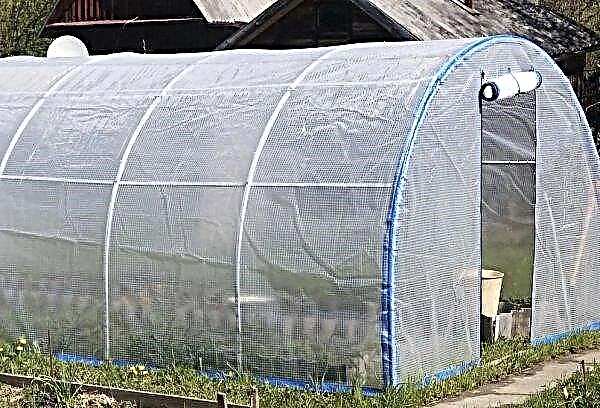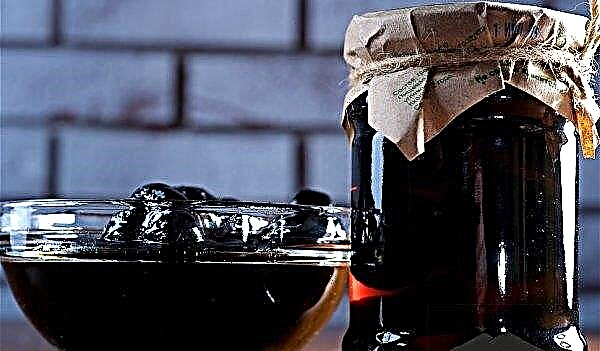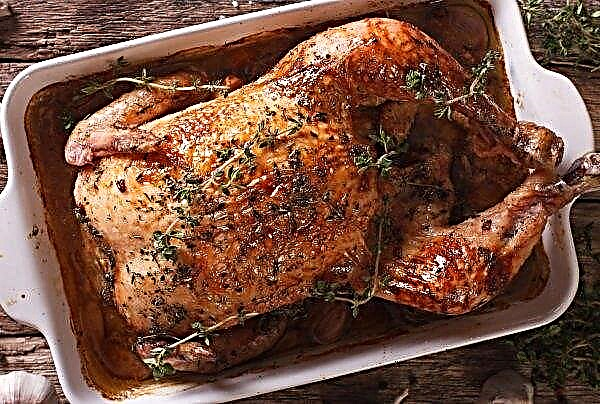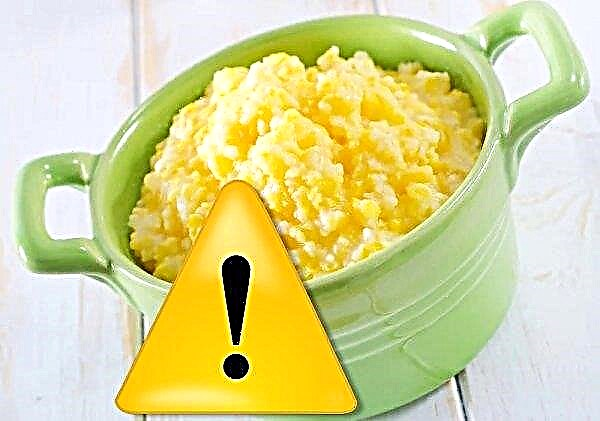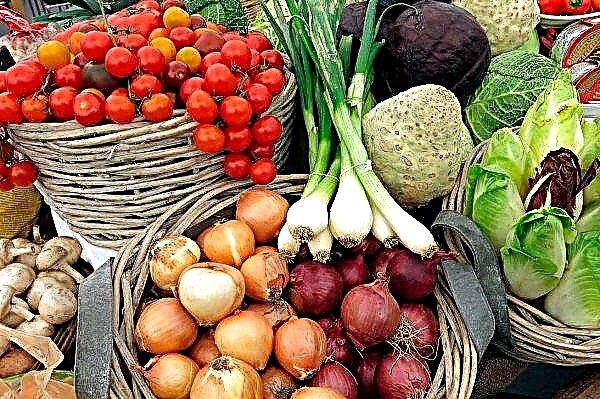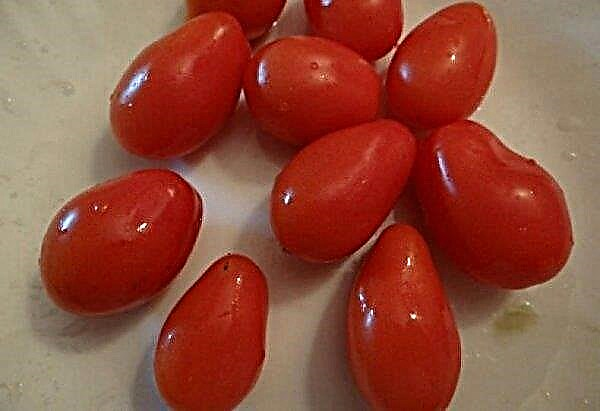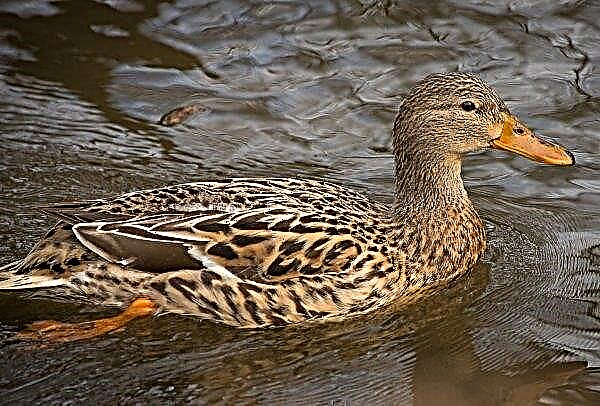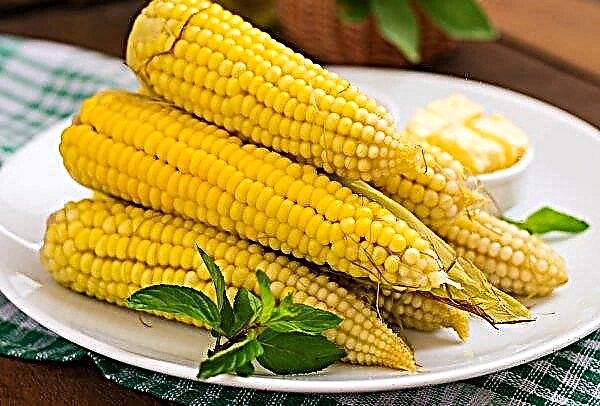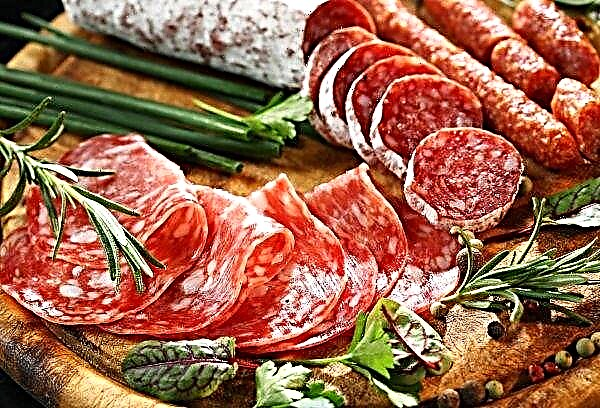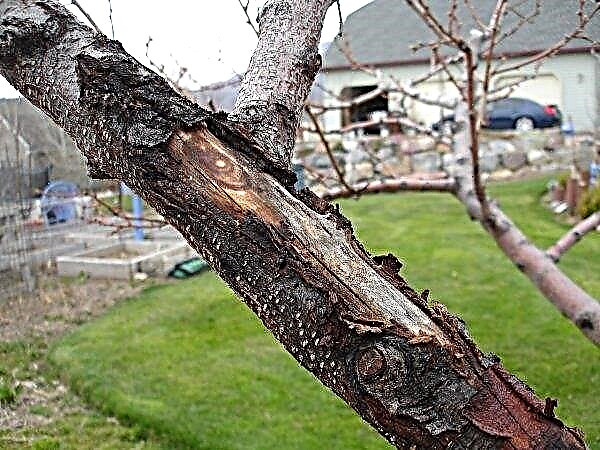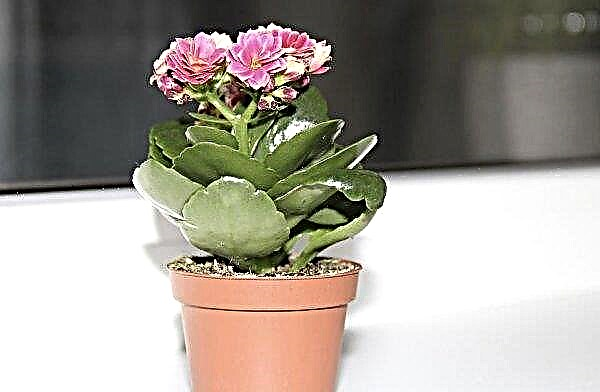Blackcurrant is a very popular berry shrub in Russia. These fruit bushes are grown in almost any garden, and each owner wants to cultivate large-fruited varieties of culture. A promising variety of Sibyll will allow you to get an early and plentiful harvest of large and tasty berries. About him in more detail - later in the article.
Description of Sibylla blackcurrant variety
The large-fruited currant variety Sibylla belongs to the Ural breeding and is characterized by a large, early ripening berry. The plant is recommended for cultivation in the central regions, as well as those characterized by unstable weather and a cool summer climate. The weight of sweet and sour fruits with a refreshing taste reaches 5 g. Every year, the plant grows a good crop, which after harvest retains freshness for a long time, which contributes to its transportation over long distances.
Did you know? In the world there are thousands of varieties of currants, among them there are bushes with black, red, pink, yellow and even transparent berries.
Fresh berries can be stored for 10-14 days. Sibylla is characterized by good resistance to the diseases characteristic of currants, due to which it receives good reviews from gardeners, but can be attacked by a kidney tick. In the description of the variety, the author indicates that it can be successfully grown both on small plantations and in huge industrial areas.
Selection history
Sibylla black currant is an early variety with large berries, which is the result of selection by V. Ilyin, an employee of the South Ural Research Institute, In 2008, a new cultivar was introduced into the State Register. In the process, the parental varieties Bredthorpe (Karelian) and the Seedling of the Golubka were crossed. The result was good, and the new plant possessed such qualities as increased productivity and resistance to external irritants (diseases and insects). The variety is zoned for cultivation in the Central region and the Far East.
The result was good, and the new plant possessed such qualities as increased productivity and resistance to external irritants (diseases and insects). The variety is zoned for cultivation in the Central region and the Far East.
Appearance, characteristics of berries, ripening time, yield
Sibylla looks like a medium-sized shrub, the height of which does not exceed 150 cm, has a neat crown and powerful fruit-bearing branches with a diameter of 150 to 400 mm. Young shoots are covered with smooth green bark, which bursts with age and becomes rough. Fruit branches are located on branches at an angle of 45 degrees, they are painted brown and slightly pubescent. The bush twice a season requires sanitary cleaning of the crown, during which damaged, diseased and dry fragments are cut out.
Without this procedure, he is prone to thickening the crown, which is bad for yield. The variety is also seen in the frequent lowering of the lower branches to the ground under the weight of the crop or heavy rainfall, so it is recommended to use a garter to a circular support or lodging restraints in the form of plastic boxes installed under the plant. After pruning, the growth of this year, which turned out to be superfluous, is suitable for use as cuttings for propagating the variety. They should be clean from bacterial and fungal diseases, and should not have broken parts. The leaf consists of 5 fragments, which is typical for shrubs of this family. It is not smooth, but slightly wrinkled, painted in light green, covered with small sharp teeth along the edge, attached to the branches with a long thin stalk. The bush loses coverage in about 35-60 days after the crop is harvested.
They should be clean from bacterial and fungal diseases, and should not have broken parts. The leaf consists of 5 fragments, which is typical for shrubs of this family. It is not smooth, but slightly wrinkled, painted in light green, covered with small sharp teeth along the edge, attached to the branches with a long thin stalk. The bush loses coverage in about 35-60 days after the crop is harvested.
The first buds appear on the crop in the last May decade or in early June, it depends on the climate zone. The flowers are small, inconspicuous, have a spherical shape and pink color of small petals. Collected in long inflorescences (4-6 cm), which do not require pollinating cultivars nearby to form full-fledged berries. Sibylla is a self-fertile plant. During flowering, the shrub does not emit a sweet smell characteristic of other plants, so bees and other insects are not interested in them.
Did you know? Currant got its name in Russian from the word “stench”, which meant “smell”, because blackcurrant berries have a pronounced smell due to the large amount of essential oils.
The first 2–3 years of vegetation, it is desirable to manually remove fruit formations on the currant, as this contributes to the rapid growth of skeletal branches and roots of the bush. Sibylla berries are medium and large in size from 2 to 5 g and rounded in shape, covered with a thin smooth skin, painted in glossy black. The internal pulp of the fruit has a yellow-green color and contains small seeds that are practically not noticeable when consumed. Taste good, the fruits are sweet and sour, dessert taste. Due to the elasticity of the inflorescences on which the berries are fixed, the crop is suitable for mechanical harvesting. The berries have a good sweet-sour taste, so they are used in cooking, making juices, cold and hot drinks, jam, confiture or jam. It is undesirable to use the Sibylla crop to create wines, because berries contain more sugar than acid. This culture is also in demand in home medicine, and, depending on the recipe, any parts of this plant (leaves, fruits and bark) can be used. All kinds of tinctures and decoctions are prepared from them. The most famous properties of culture are tonic, restorative and anti-inflammatory.
The berries have a good sweet-sour taste, so they are used in cooking, making juices, cold and hot drinks, jam, confiture or jam. It is undesirable to use the Sibylla crop to create wines, because berries contain more sugar than acid. This culture is also in demand in home medicine, and, depending on the recipe, any parts of this plant (leaves, fruits and bark) can be used. All kinds of tinctures and decoctions are prepared from them. The most famous properties of culture are tonic, restorative and anti-inflammatory.
Currants cannot be kept fresh for a long time, so it is advisable to process it soon after harvesting. The hostess has about 10-14 days to use the berries, maybe a little more, depending on the temperature conditions. The crop of large-fruited berries can be frozen, because after thawing they do not lose their taste and aroma and to a large extent retain useful properties. Varieties of red and white currants surpass their black-fruited relative in the content of minerals and vitamins.
Important! Despite self-pollination, the variety Sybil bears fruit more abundantly, and its berries are formed larger if other varieties of blackcurrant are planted in the garden.
But in its composition there are many important elements for humans, such as: vitamins of group B and PP, C, A, H, phosphorus and potassium, magnesium and calcium, copper and iodine, zinc and iron, dietary fiber, as well as volatile , monosaccharides, essential oils, disaccharides, pectin, saturated and unsaturated fatty acids. The fruits of black currant are a low-calorie product: in 100 g of berries there are only 44 kcal, so they can be used in a diet.
Advantages and disadvantages of the variety
Russian gardeners have been growing Sybill black currants for the second decade under various conditions: in a mild and harsh climate, on chernozem, in clay or sandy soil. But invariably this variety receives many good reviews.
- Advantages
- large berries;
- pleasant taste of fruits;
- good productivity without drops;
- ability to bear fruit without pollinators;
- resistance to low temperatures and drought;
- resistance to viral diseases and powdery mildew;
- the possibility of mechanized harvesting.
- Disadvantages:
- tendency to damage by kidney mites;
- the formation of drought berries of different sizes.
Agricultural technology
Sibyllus is grown in almost the same way as any other berry shrub. Having correctly planted the currant seedling, the gardener can hope for a healthy and harmonious development of the plant and good yield over the next 13-15 seasons. In this procedure, it is important to choose the location of the crop and the quality of the planting material, because it is precisely on this that the rapid adaptation and development of the seedling in the first years of the growing season depends.
Important! You can check the elasticity of the roots when buying a seedling without damaging the wood, for example, wrap them in several layers around the finger. Viable and moist during twisting will not break, and dry ones will be damaged in several places.
Seedlings of the desired variety are best bought in fruit nurseries specializing in berry crops. This will save the gardener from disappointment if after a few years the grown plant will significantly differ from the characteristics declared in the description of the variety.
How to choose a currant seedling:
- The plant should have a well-developed above-ground part, the height of which is at least 50 cm.
- At least 3–4 well-developed shoots are desirable on the shrub, the bark of which is painted in light gray-brown color and has a smooth structure.
- A very important parameter of choice is the root system of a young plant. It should be well branched, consisting of several thick fragments and many small, fibrous ones. It is imperative that the roots are moist and resilient, with pink and white wood at the break.
- It is unacceptable that mechanical damage, the presence of mold or fungi are observed on the roots or branches of currant.
- It is best to buy a two-year-old plant, as a bush of this age quickly takes root in a new place and grows.
- In no case should you buy currants that have significant dried fragments, as well as deformation of the aboveground or underground parts.
- It is recommended to carefully examine the growth buds on the seedling, because it is they who are assigned to ensure the proper development of the plant during the adaptation period in a new place.
- If possible, it is advisable to purchase young currants in a container having a closed root system.

Seat selection and landing
Sibylla's frost resistance is very high, which is why the plant is recommended for cultivation in the risky farming zone. Planting material is determined for a permanent place in the soil at the beginning of spring, almost immediately after the snow melts. Given the growing region, planting work can be carried out in the first April decade or in early May. In nurseries, currant bushes are planted in the autumn period (in October), which favorably affects the plant, since during this period there is no heat and enough moisture in the ground.
It is advisable to prepare the soil for cultivating the currant in advance, it will be optimal to run a couple of months before the work, i.e., the soil is prepared for planting at the beginning of the warm season before winter and, conversely, for autumn planting - from spring. The selected area should be deep digged to a depth of about 25 cm, after which using garden forks to extract stones, roots and plant debris from the ground.
Did you know? It is believed that it is better for children to eat the fruits of black currant, adults - red, and older - white. This is due to the different composition of currants in different colors.
It is also necessary to introduce nutrients, for example, organic fertilizers (cattle manure, humus, compost), which are applied at the rate of 7-10 kg (about a bucket) for each adult plant. The introduction of mineral fertilizers, such as nitroammophoska, is also recommended at the rate of 30–40 g / 1 m² or a mixture consisting of 20 g of potassium sulfate and the same amount of superphosphate and urea per 1 m². Fertilizers are laid out at marked boundaries on the soil surface before digging begins. This is convenient because in the process, nutrients are evenly mixed with the ground. At the end of the preparatory work, the future landing site should be well poured (to the mud) with heated water. In order for large-fruited currants to give a good harvest, it needs fertile land with a loose structure, which allows moisture and air to pass through well. A slightly acidic or neutral reaction is desirable for the soil, since acidity is reflected not only in the development of the shrub, but also in the taste of the fruits.
This is convenient because in the process, nutrients are evenly mixed with the ground. At the end of the preparatory work, the future landing site should be well poured (to the mud) with heated water. In order for large-fruited currants to give a good harvest, it needs fertile land with a loose structure, which allows moisture and air to pass through well. A slightly acidic or neutral reaction is desirable for the soil, since acidity is reflected not only in the development of the shrub, but also in the taste of the fruits.
If the acidity is high, then soil indicators can be brought to the desired value by adding hydrated lime or chalk powder. Despite the fact that currants love moderate moisture in the root zone, it is not necessary to plant shrubs near artificial or natural reservoirs, as well as in places with groundwater lying close to the surface. Such a location can contribute to the fact that annually the culture will be exposed to fungal diseases and root rot.
Fruit crops need good lighting, this must be taken into account when planning the location of the plant. It is not recommended to plant a berry plantation next to tall plants (trees, grapes on a trellis) or the shading walls of home gardens. The site must be carefully selected, because blackcurrant will grow in this place over the next 15 years. An unsuccessful location may be the reason for a future shrub transplant. Usually currants are planted in rows, observing an interval of at least 200 cm. This allows the garden owner to take care of the crop without any problems. It is necessary to leave a distance of 100-150 cm between the plants. Not far from Sibylla you can plant a fruitful white-fruited currant variety Belaya Versailles. Such an agronomic technique contributes to the fact that all the side branches of a young shrub will develop equally, which will favorably affect productivity.
Usually currants are planted in rows, observing an interval of at least 200 cm. This allows the garden owner to take care of the crop without any problems. It is necessary to leave a distance of 100-150 cm between the plants. Not far from Sibylla you can plant a fruitful white-fruited currant variety Belaya Versailles. Such an agronomic technique contributes to the fact that all the side branches of a young shrub will develop equally, which will favorably affect productivity.
If a currant is formed from currant bushes, then the bushes are much closer to each other than is recommended for culture. But the gardener should take into account that densification of plantings will reduce the quantity and quality of berries on plants. Seedlings are planted to a depth of at least 50 cm. The planting pit should be sized so that not only the currant root system, but also a 10 cm drainage layer located at the bottom can freely fit in it.
Care
Black currant is not too demanding to care for, but nevertheless, for a good fruiting of the crop, the gardener needs to adhere to a minimum work plan consisting of moistening and loosening the soil, as well as irrigation, pruning and fertilizing the plantings. Throughout the warm season, it is important to provide the bush with a moist root layer, but at the same time it is undesirable to do this in excess, thereby contributing to stagnation of water.
Special attention to watering is required from a gardener by a young plant in the first few years of vegetation. Before the procedure, the condition of the soil and the amount of precipitation should be taken into account. With a long absence of rain, the bushes are watered three times a month, using at least a bucket of water for each plant. It is also important to moisten the bushes in time during flowering, crop formation and fruit ripening.
Did you know? Over the past 30 years, many seedlings of fruit and berry crops have visited the Earth’s orbital station, where ISS biologists studied them under zero gravity. Among the others were shrubs of currants, raspberries, as well as apple trees and cereals.
Long-term drought contributes to the appearance of deformed and hard berries. It is advisable to use clean water, preferably rain or tap water, but which has settled for several days. Humidify the currant under the root, so that moisture does not fall on the leaves, so as not to cause the development of fungal spores.
During the summer, currants are fed three times, applying fertilizers taking into account the soil substrate and the phase of development of the crop. Traditionally, such periods are recommended for this: the period of snow melting, the beginning of flowering and autumn. For the first feeding, you can take any fertilizer containing nitrogen.This can be organic matter (cattle or poultry manure), as well as ammonium nitrate or urea. The second top dressing is carried out using phosphorus and potassium, for this purpose ready-made complex mineral fertilizers for berry bushes are also used. Agronomists recommend fertilizing currant bushes only under the root, because, getting on the leaves, fertilizers (both organic and minerals) contribute to the appearance of chemical burns and injure the plant.
The second top dressing is carried out using phosphorus and potassium, for this purpose ready-made complex mineral fertilizers for berry bushes are also used. Agronomists recommend fertilizing currant bushes only under the root, because, getting on the leaves, fertilizers (both organic and minerals) contribute to the appearance of chemical burns and injure the plant.
Pest and Disease Control
This variety has good immunity, therefore, in favorable conditions, it weakly responds to the attack of fungi and viral diseases characteristic of currants. But if the bush grows in conditions of crowding, thickening of the crown or it is watered on a leaf, then it is possible to develop diseases such as terry curls, powdery mildew, rust, anthracnose or septoria. To prevent the spread of infection, preventive spring and autumn treatments with chemicals containing copper are performed.
Important! A person involved in the chemical treatment of shrubs from pests and diseases, the first thing to do is to take care of personal safety. To do this, he must use special clothing that covers all parts of the body and head, and special glasses and a respiratory mask can protect his eyes and respiratory organs.
For these purposes, it is recommended to use fungicides with a wide spectrum of action (copper sulfate, Bordeaux mixture, "Quadris", "Vectra"). The bushes are also treated with insecticides that destroy at any stage of development such insect pests as spider and bud mites, aphids, and sawflies.
Trimming and shaping a bush
From early spring, even before buds open, it is recommended that the gardener trim the crown. This procedure can be aimed at both the formation and sanitary cleaning of plants from dry and diseased elements. Carrying out the work, you should carefully inspect the plant and remove all twisted and growing shoots inside the bush. The first time the bush is trimmed after planting, all subsequent procedures begin only after the currant reaches three years of age. Fig. 1. Currant pruning: a - annual seedling; b - a biennial bush; c, d - shortening of shoots. Fig. 2. Currant bush before anti-aging pruning (a), after it (b) and pruning of the neglected bush (c). Such events will be carried out twice a year: the first time - at the beginning of the season (before buds open), the second - in the autumn, after the branches free from the leaves. On an adult shrub, crown formation is carried out so that no more than 15 fruit-bearing shoots with well-developed fruit buds are left on the currant. Damage caused by secateurs to branches is lubricated with garden var or an elastic clay solution with the addition of manure and copper sulphate.
Fig. 1. Currant pruning: a - annual seedling; b - a biennial bush; c, d - shortening of shoots. Fig. 2. Currant bush before anti-aging pruning (a), after it (b) and pruning of the neglected bush (c). Such events will be carried out twice a year: the first time - at the beginning of the season (before buds open), the second - in the autumn, after the branches free from the leaves. On an adult shrub, crown formation is carried out so that no more than 15 fruit-bearing shoots with well-developed fruit buds are left on the currant. Damage caused by secateurs to branches is lubricated with garden var or an elastic clay solution with the addition of manure and copper sulphate.
If there is a need to propagate the desired variety, blackcurrant provides many options for this: division of the bush, rooting of layering, cuttings (green or lignified shoots). Any of these methods will help the gardener maintain the quality of the bush. For carrying out, it is advisable to choose the early spring (before the swelling of the kidneys) or the autumn period.
Did you know? One of the basic laws of biology says that the larger the number of fruits on a plant, the smaller the mass of each of them. Accordingly, the smaller the berries, the larger they are.
Blackcurrant propagation:
- Rooting cuttings. In late autumn, after the plant enters a dormant period, the gardener harvests planting material, cutting healthy young branches from the bush. Their diameter should not be less than 0.5 cm and more than 1 cm, and their length should be from 15 to 20 cm. The cut is placed in a container and covered with a moist substrate (sand or peat), where it will be stored until spring. The box is taken out in a cool room with a constant temperature or placed on the bottom shelf of the refrigerator. During the winter, it is necessary to periodically check the humidity of the substrate in which the plants lie, and if necessary, spray it with water from the spray gun. In early April, cuttings are planted in a school filled with sand, sticking them obliquely at an angle of 45 degrees. When deepening branches in the soil, you should pay attention to the fact that 2-3 fruit buds remain on the surface. It is advisable to hide a currant nursery from the sun using a spunbond or a shading net. Rooting will occur in about 35–45 days. Young bushes are planted from the nursery in the fall or next spring.
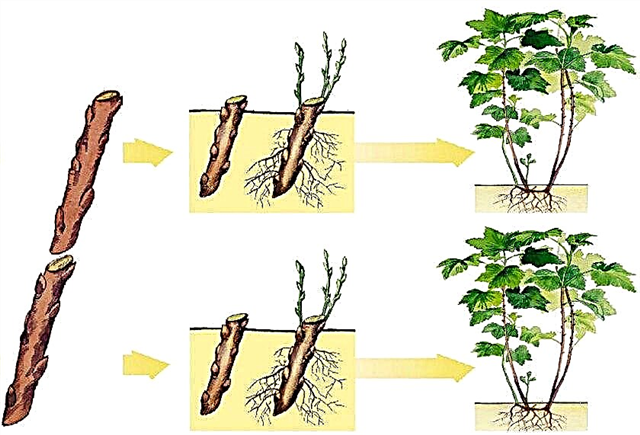
- Rooting layers. For these purposes, the gardener selects several shoots growing in the lower part of the mother shrub and, bending to the ground, puts them in longitudinal grooves, and then heaps with soil. To keep the branch in a given position, it is recommended to press it with a heavy stone or brick. In this position, the plant will remain for 6-12 months, during which it is necessary to maintain the soil under the currant moist. If propagation in this way was started in the spring, then in the autumn you can carefully check whether good roots formed on the branch, in the place of contact with the soil. If they are small, then the land is returned to the place and watered, and the branch is left in the same place until next spring, when the layering can be separated from the mother bush and planted.

- The separation of the bush. With the help of a sharp shovel, the gardener separates a part of the shrub that contains both a full root system and several overhead shoots, after which it immediately plants it in a new place.

Wintering
Since Sybil currants have excellent resistance to frost (up to -25 ° C), an adult shrub does not require additional warming for the winter in almost any climatic zone of Russia. But young bushes after autumn landing on a permanent place need to mulch the root zone and protect the aerial parts with the help of a cardboard shelter or several layers of spunbond.
Mulch, laid under the winter next to the seedling, performs not only the function of retaining moisture, but also the role of insulation for the underground part of the shrub. This layer can be created from sawdust, straw, leaves, peat, rotted humus or an additional layer of soil. During the autumn planting, it is desirable that the daily temperature indicators have a value within +7 ... + 10 ° C, so it is recommended that the gardener postpone the event if significant cooling is expected.
Harvesting and transportation of the crop, shelf life of berries
Berries begin to pick as soon as they acquire the color and size characteristic of the Sibyl variety, usually the ripening period begins in July. Depending on the climate in which the bushes are grown, the fruits may sing a few weeks later or earlier. Currants can not be stored fresh for a long time, so it is advisable to process the berries soon after harvesting. The hostess has about 10 days to use them, maybe a little more, depending on temperature conditions. The crop of large-fruited berries can be frozen, because after thawing they do not lose their taste and aroma, and also to a large extent retain useful properties. If you intend to transport berries of this variety, it is recommended to harvest in small, but dense containers, the volume of which does not exceed 300-500 ml and having openings on the bottom for the drain of berry juice.
The crop of large-fruited berries can be frozen, because after thawing they do not lose their taste and aroma, and also to a large extent retain useful properties. If you intend to transport berries of this variety, it is recommended to harvest in small, but dense containers, the volume of which does not exceed 300-500 ml and having openings on the bottom for the drain of berry juice.
Sybil well tolerates transportation, but this requires special transport, for example, refrigerators with a constant temperature (+2 ... + 8 ° C). Even an inexperienced gardener can grow black currants, so it is worth planting one or more bushes in the garden or in the country. The large-fruited variety of Sibyll will give a gardener caring for him an abundant and tasty crop.




